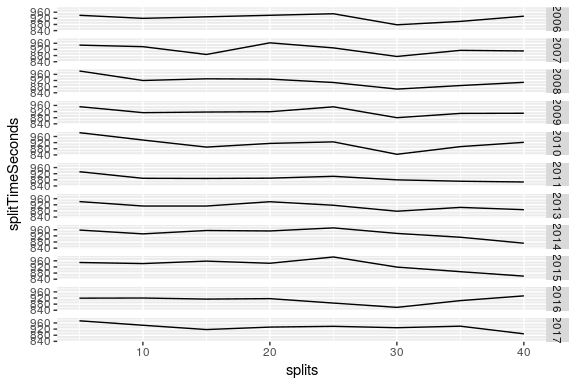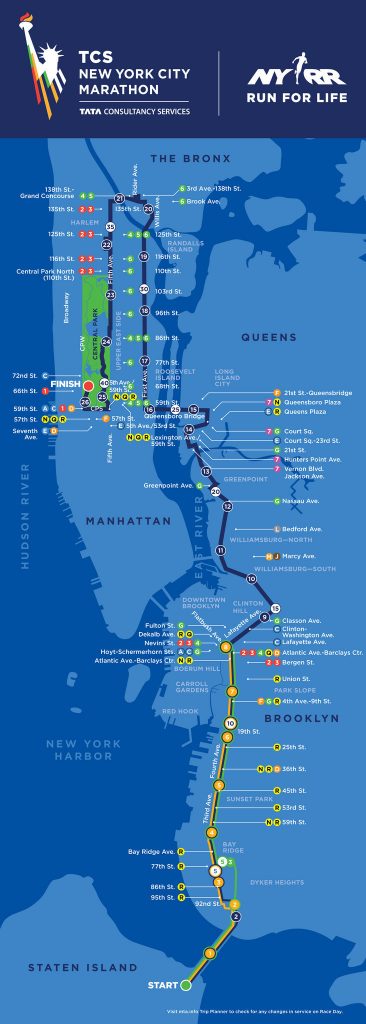Every marathon fan and stakeholder cannot wait for the athletes to break 2-hour barrier. The closest they have come is Eliud Kipchoge’s 2:00:25 in Monza. That in itself is a great fete, however it would not have counted as a world record. This is because the track did not comply with the IAAF marathon rules. What I would be looking at in this series is marathons that are eligible for the world record examples being New York, Berlin, London, Tokyo, Chicago and Amsterdam. I will profile the marathons using data and see what it will take for one to break the barrier. I will concentrate on male athletes and the data used is from 1990-2017. I got the data from NYC marathon official page.
According to the experts, the least likely track is New York. It is said to be toughest marathon that one can run. This is because of its terrain. The figure below shows the course of the 2017 marathon.
People who live in New York will understand why it is tough from the image above. For the rest of us, I added the elevation graph for a better idea of why it is the toughest. Elevation is the distance from ground level. The major hill in New York is found from around 37km upto the end. It is not as bad as Boston when it comes to elevation but it is its position that really challenges the athletes. It is also the change in climb rate especially at the race that is tough on the athletes.

Based on that, we can look at the splits seconds per km by the winners from 2006 and see how the times changed during the race.

The most steady races ran was in 2011, which happens to be when the course record was set by Geoffery Mutai, time was 2:05:06. The times changed based on the elevation. We can see that time at 25km split reduced and picked up at 30km.
Below is a graph showing the way the finishing times changed over the years. We can only see a drop of time between 2009 and 2011. The rest of the periods the time has has been fluctuating.

One interesting thing from the data is that the most titles that one athlete has held is 2, and there are only 5 athletes to do that. Among the 5, only three have done it by defending their title. Title defence was done twice in the 1990s and once between 2000 and today. Only Dos Santos was able to reclaim the title. This continues to show just how tough this marathon is. The graph below shows the athletes who won the title over the years.


Unlike the lack of dominance among athletes, countries have dominated the marathon of late. People would have guessed that the Ethiopians and the Kenyans have dominated, however the Ethiopians have only had 2 winners. Mexico has had more winners than them. From the graph below, we can be able to see the distribution of the title based on countries.

We can also plot the graph above based on the years. This will let us see when the countries won and was there a shift in dominance over time or the wins by Kenya was distributed over time.

As we can see above, there has only been one period where there was total dominance by the Kenyans. All the titles won by the Mexicans was during the same time.
The oldest athlete to win the marathon was Paul Tergat in 2005 at the age of 36. The youngest athlete was Ghirmay Ghebreslassie aged 20. The majority of winners are aged 28. Does this mean that this marathon requires experience? That is something that we can also take a look at. Below shows the age distribution of the athletes.

A cool fact about this marathon, 2011 happened to have the coolest temperature among these years, no pun intended. The lowest temperature was 2 degrees. From the figure below obtained from TATA, its seems that the cooler the temperature the better the time.

In conclusion, we have seen that it will take some time for one to break the 2 hour barrier. There are some things that have to come together for this to be achieved. Below is a summary of the suggested right condition and person based on the data:
- The best strategy would be to have a steady pace as shown by Mutai in 2011.
- The athlete has to have experience, so maybe years 27-28. Although with the rise of technology this might change.
- The runner will likely come from Kenya, if history was to have a say.
- Temperature plays a big part so cool weather conditions are preferable.
- Chances of the past winners to breaking the barrier are low; we are looking at a new winner.


You guys are my inspiration to love the #DataVisualisation and #DatAnalytics. Keep it up! #HeptAnalytics #YvonneWambui